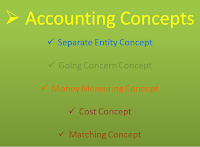Accounting Concepts - Meaning – Explanation

Accounting
Concepts are those fundamental basic and generally accepted rules which are
used while preparing the financial statements. Accounting Concepts are parts of Accounting Principles And Generally Accepted Accounting Principles (GAAP).
Following
are the most important accounting concepts of Accounting:
1. Business Entity / Separate Entity Concept
A
business entity is an independent entity and which is separated from the
owners. All the Transactions are recorded from the point of view of the
business. The business entity has its own assets and liabilities. Personal
transactions of owner are not taken into account and are not recorded in the
books of accounts of the business. Only those transactions of the owners are
recorded that affect the financial position of the business.
For Examples in case of transactions for Capital and Drawings, these transactions are recorded in the books of business.
For Examples in case of transactions for Capital and Drawings, these transactions are recorded in the books of business.
2. Going Concern Concept
Going
Concern Concept implies that the business does not have any intention to close
down the business in near future so the assets and liabilities are not shown at
market value.
For Example, the company charges the Depreciation on equipment by the applicable method and are not considering the windup of the assets.
For Example, the company charges the Depreciation on equipment by the applicable method and are not considering the windup of the assets.
3. Money Measurement Concept
According
to this concept, only those transactions are recorded which are expressed in
terms of money.
For example, Sold goods for Cash Rs.90,000 is an event so it is a transaction but order for the supply of goods to seller is not an event in Accounting as it is not expressed in terms of money so it is not a transaction.
For example, Sold goods for Cash Rs.90,000 is an event so it is a transaction but order for the supply of goods to seller is not an event in Accounting as it is not expressed in terms of money so it is not a transaction.
4. Cost Concept
According
to this concept, an asset is recorded at its historical cost, which we get at
the time of purchase of the asset, and this cost becomes the basis for value of
the asset. However, the cost
concept does not mean that the book
value of the asset can not be shown.
For
Example, we purchase Plant & Machinery for Rs.80,000 then this cost is the
historical cost of the asset and this asset is recorded at cost in the balance
sheet.
5. Dual Aspect Concept
Dual
aspect means every transactions having two fundamental aspect one involving the
receiving of the benefit and others to give the benefit to others. For every
debit, there is a credit with an equal amount.
For
Example, Mr. A purchase goods for Rs.30,000 have two fundamental aspects. One
is that the goods are come into the business and second one is that the cash is
going out of the business. But, both debit and credit remain equal throughout
the accounting period.
6. Accounting Period Concept
According
to this concept, financial statements of the business are prepared during a
particular period and at the end of accounting period, financial performance
and financial position of the business are determined.
Some
Businesses prepare financial statements monthly, some quarterly, some
semi-annually and usually many businesses prepare financial statements
annually.
Matching
Concept argues that all those expenses that are incurred during a particular
period of time to generate revenue must be set off against that revenue,
otherwise, true financial position of the business can not be drawn.
For
Example, Salaries paid to employees are expenses for the business for
generating the revenue for the business. If the business does not pay the
salaries to employees in accounting year 2014, even though, the employees
generate the revenue for the business in 2014, so these expenses should be set
off against the revenue of 2014 only, even though, the business pay salaries to
them in 2015.
8. Realization Concept
According
to this Concept, Sales is recognized and recorded at the point of time when the
buyer becomes the owner of the goods sold and legally liable to pay the bill.
For
Example, Mr. A places and order for the supply of goods to Mr. B
(Supplier). Mr. B sends goods to Mr. B,
10 days after the receipt of this order and Mr. A makes payments to Mr. B, 5
days after receiving the delivery of goods. In this case, we recognize revenue
at the time when Mr. B delivered the goods to Mr. A, i.e, before the delivery. We
neither record the revenue at the time when he / she has received the order for
the supply of goods nor at the time when he / she makes payments to his / her
supplier (Mr. B).
Comments